Taxation Fundamentals: Explanation of Income Tax and NICs Payment
VerifiedAdded on 2023/06/15
|9
|2226
|228
AI Summary
The article provides a detailed explanation of the payment of income tax and NICs, along with calculations. It also discusses tax evasion and avoidance, recent policies for reducing them, and the assessment of personal income tax or capital gains tax. The article is relevant for students studying taxation fundamentals and related courses.
Contribute Materials
Your contribution can guide someone’s learning journey. Share your
documents today.
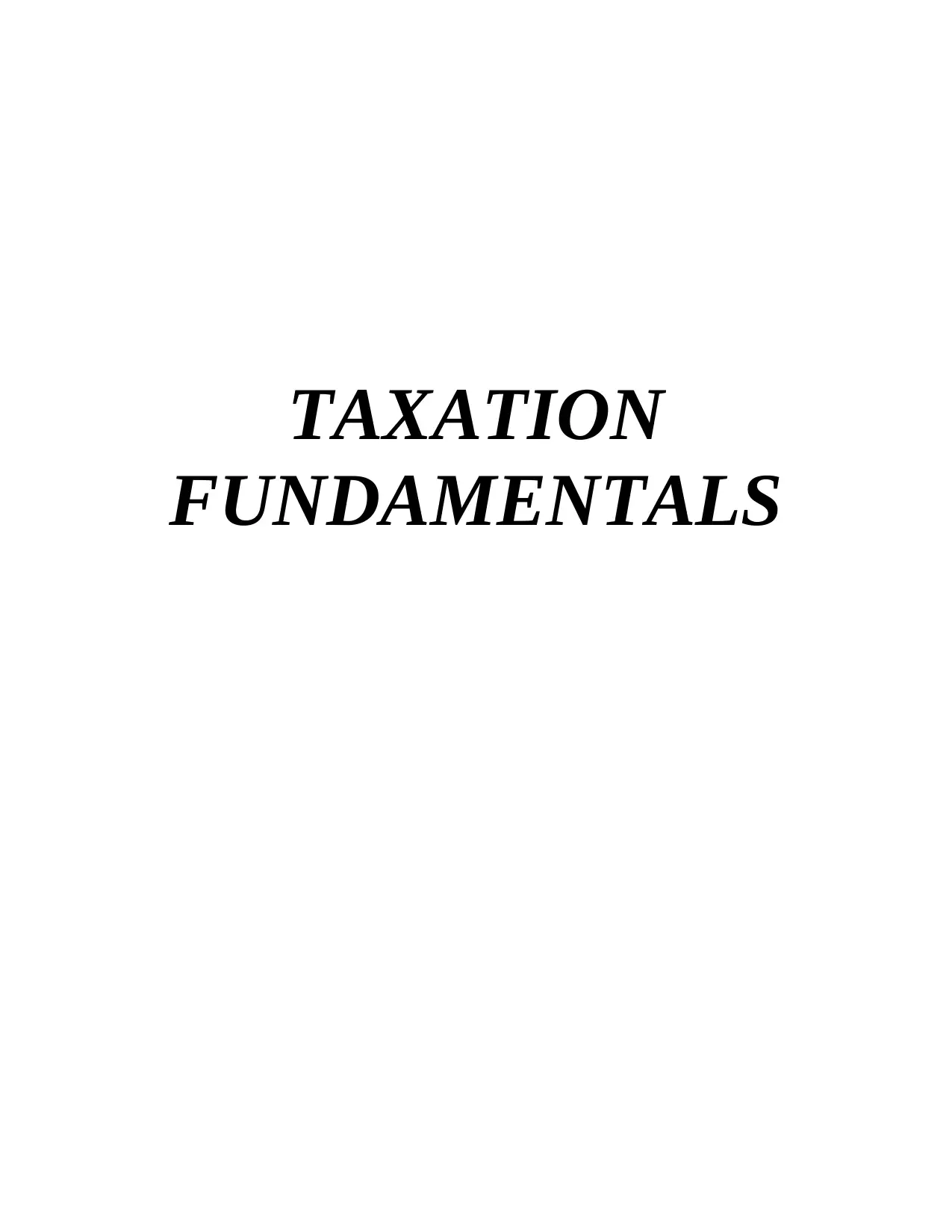
TAXATION
FUNDAMENTALS
FUNDAMENTALS
Secure Best Marks with AI Grader
Need help grading? Try our AI Grader for instant feedback on your assignments.

Table of Contents
SECTION A.....................................................................................................................................3
Make a report giving the detailed explanation about the payment of income tax and it NICs.. .3
SECTION B.....................................................................................................................................5
PART 1............................................................................................................................................5
(a) Calculate the income tax and NIC for both the options.........................................................5
(b) Perform the calculations of disposable income after deductions. ........................................6
(c) Which of the two option will be best for Gloria for the taxation perspective. .....................6
PART 2............................................................................................................................................7
(a) Distinguish between tax evasion and avoidance with the help of examples.........................7
(b) Analyse the two recent policies of the last five years for the reduction of tax avoidance and
evasion.........................................................................................................................................7
PART 3............................................................................................................................................7
Analyse how the HMRC will assess whether Mrs Jill Johnson will be subject to personal
income tax or capital gains tax using determined instances.......................................................7
REFERENCES................................................................................................................................9
SECTION A.....................................................................................................................................3
Make a report giving the detailed explanation about the payment of income tax and it NICs.. .3
SECTION B.....................................................................................................................................5
PART 1............................................................................................................................................5
(a) Calculate the income tax and NIC for both the options.........................................................5
(b) Perform the calculations of disposable income after deductions. ........................................6
(c) Which of the two option will be best for Gloria for the taxation perspective. .....................6
PART 2............................................................................................................................................7
(a) Distinguish between tax evasion and avoidance with the help of examples.........................7
(b) Analyse the two recent policies of the last five years for the reduction of tax avoidance and
evasion.........................................................................................................................................7
PART 3............................................................................................................................................7
Analyse how the HMRC will assess whether Mrs Jill Johnson will be subject to personal
income tax or capital gains tax using determined instances.......................................................7
REFERENCES................................................................................................................................9
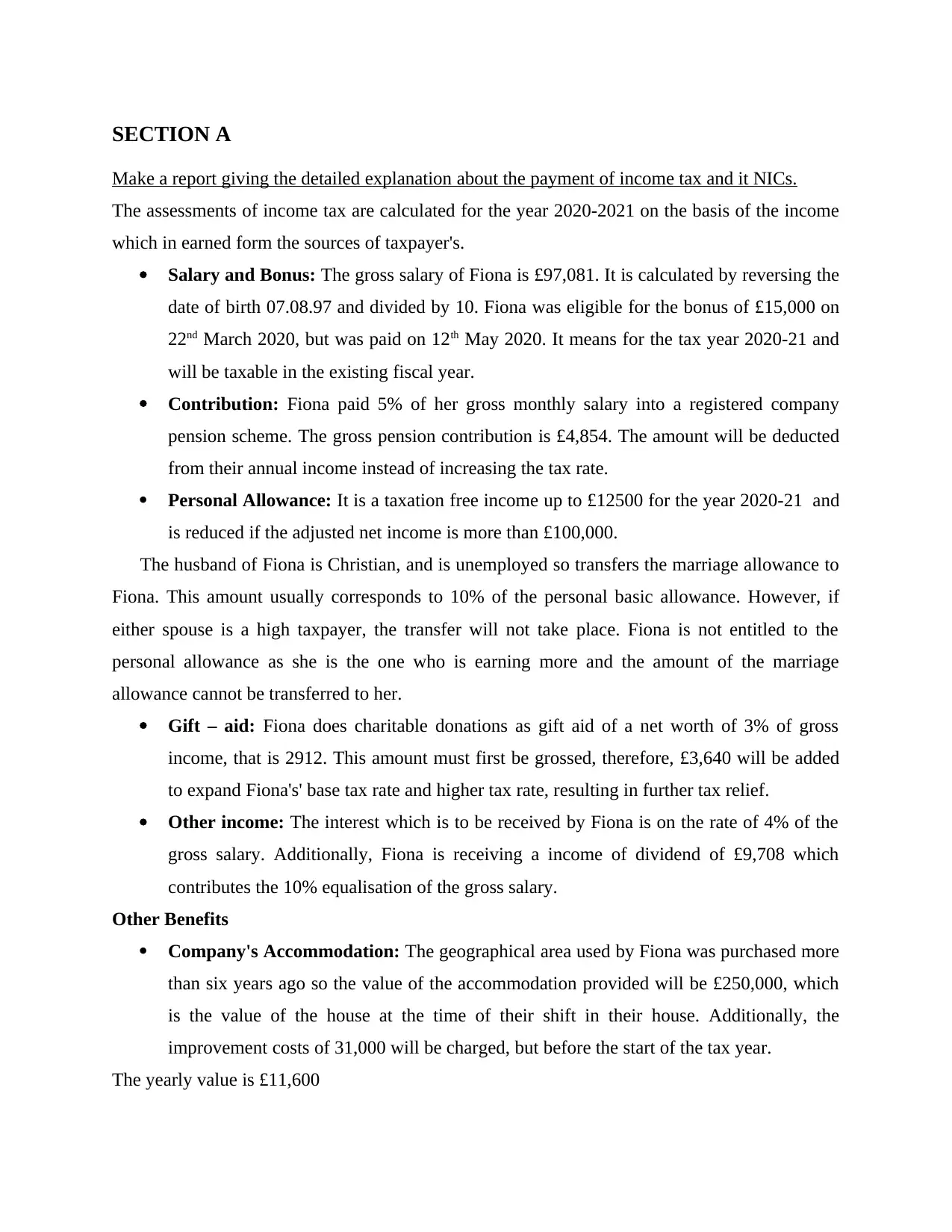
SECTION A
Make a report giving the detailed explanation about the payment of income tax and it NICs.
The assessments of income tax are calculated for the year 2020-2021 on the basis of the income
which in earned form the sources of taxpayer's.
Salary and Bonus: The gross salary of Fiona is £97,081. It is calculated by reversing the
date of birth 07.08.97 and divided by 10. Fiona was eligible for the bonus of £15,000 on
22nd March 2020, but was paid on 12th May 2020. It means for the tax year 2020-21 and
will be taxable in the existing fiscal year.
Contribution: Fiona paid 5% of her gross monthly salary into a registered company
pension scheme. The gross pension contribution is £4,854. The amount will be deducted
from their annual income instead of increasing the tax rate.
Personal Allowance: It is a taxation free income up to £12500 for the year 2020-21 and
is reduced if the adjusted net income is more than £100,000.
The husband of Fiona is Christian, and is unemployed so transfers the marriage allowance to
Fiona. This amount usually corresponds to 10% of the personal basic allowance. However, if
either spouse is a high taxpayer, the transfer will not take place. Fiona is not entitled to the
personal allowance as she is the one who is earning more and the amount of the marriage
allowance cannot be transferred to her.
Gift – aid: Fiona does charitable donations as gift aid of a net worth of 3% of gross
income, that is 2912. This amount must first be grossed, therefore, £3,640 will be added
to expand Fiona's' base tax rate and higher tax rate, resulting in further tax relief.
Other income: The interest which is to be received by Fiona is on the rate of 4% of the
gross salary. Additionally, Fiona is receiving a income of dividend of £9,708 which
contributes the 10% equalisation of the gross salary.
Other Benefits
Company's Accommodation: The geographical area used by Fiona was purchased more
than six years ago so the value of the accommodation provided will be £250,000, which
is the value of the house at the time of their shift in their house. Additionally, the
improvement costs of 31,000 will be charged, but before the start of the tax year.
The yearly value is £11,600
Make a report giving the detailed explanation about the payment of income tax and it NICs.
The assessments of income tax are calculated for the year 2020-2021 on the basis of the income
which in earned form the sources of taxpayer's.
Salary and Bonus: The gross salary of Fiona is £97,081. It is calculated by reversing the
date of birth 07.08.97 and divided by 10. Fiona was eligible for the bonus of £15,000 on
22nd March 2020, but was paid on 12th May 2020. It means for the tax year 2020-21 and
will be taxable in the existing fiscal year.
Contribution: Fiona paid 5% of her gross monthly salary into a registered company
pension scheme. The gross pension contribution is £4,854. The amount will be deducted
from their annual income instead of increasing the tax rate.
Personal Allowance: It is a taxation free income up to £12500 for the year 2020-21 and
is reduced if the adjusted net income is more than £100,000.
The husband of Fiona is Christian, and is unemployed so transfers the marriage allowance to
Fiona. This amount usually corresponds to 10% of the personal basic allowance. However, if
either spouse is a high taxpayer, the transfer will not take place. Fiona is not entitled to the
personal allowance as she is the one who is earning more and the amount of the marriage
allowance cannot be transferred to her.
Gift – aid: Fiona does charitable donations as gift aid of a net worth of 3% of gross
income, that is 2912. This amount must first be grossed, therefore, £3,640 will be added
to expand Fiona's' base tax rate and higher tax rate, resulting in further tax relief.
Other income: The interest which is to be received by Fiona is on the rate of 4% of the
gross salary. Additionally, Fiona is receiving a income of dividend of £9,708 which
contributes the 10% equalisation of the gross salary.
Other Benefits
Company's Accommodation: The geographical area used by Fiona was purchased more
than six years ago so the value of the accommodation provided will be £250,000, which
is the value of the house at the time of their shift in their house. Additionally, the
improvement costs of 31,000 will be charged, but before the start of the tax year.
The yearly value is £11,600
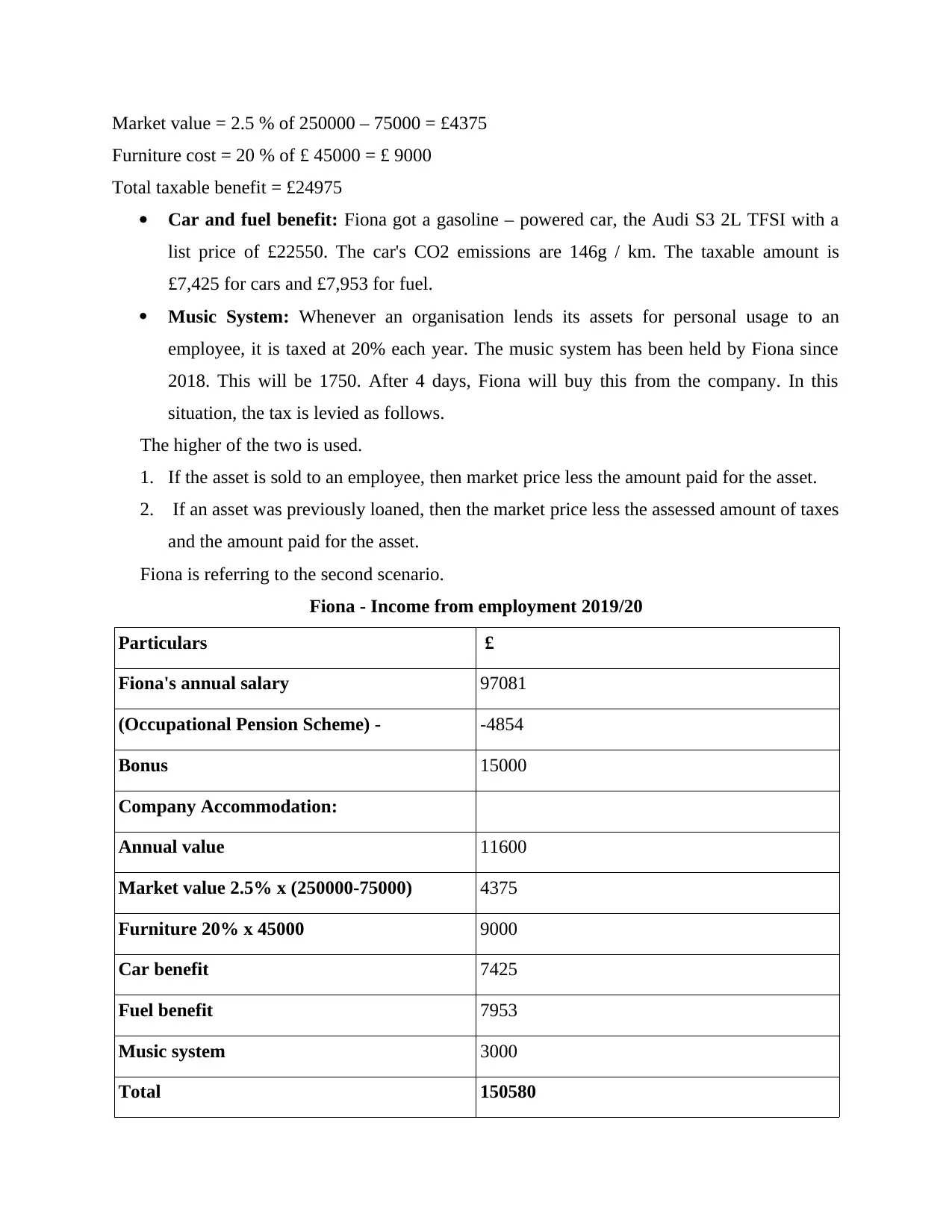
Market value = 2.5 % of 250000 – 75000 = £4375
Furniture cost = 20 % of £ 45000 = £ 9000
Total taxable benefit = £24975
Car and fuel benefit: Fiona got a gasoline – powered car, the Audi S3 2L TFSI with a
list price of £22550. The car's CO2 emissions are 146g / km. The taxable amount is
£7,425 for cars and £7,953 for fuel.
Music System: Whenever an organisation lends its assets for personal usage to an
employee, it is taxed at 20% each year. The music system has been held by Fiona since
2018. This will be 1750. After 4 days, Fiona will buy this from the company. In this
situation, the tax is levied as follows.
The higher of the two is used.
1. If the asset is sold to an employee, then market price less the amount paid for the asset.
2. If an asset was previously loaned, then the market price less the assessed amount of taxes
and the amount paid for the asset.
Fiona is referring to the second scenario.
Fiona - Income from employment 2019/20
Particulars £
Fiona's annual salary 97081
(Occupational Pension Scheme) - -4854
Bonus 15000
Company Accommodation:
Annual value 11600
Market value 2.5% x (250000-75000) 4375
Furniture 20% x 45000 9000
Car benefit 7425
Fuel benefit 7953
Music system 3000
Total 150580
Furniture cost = 20 % of £ 45000 = £ 9000
Total taxable benefit = £24975
Car and fuel benefit: Fiona got a gasoline – powered car, the Audi S3 2L TFSI with a
list price of £22550. The car's CO2 emissions are 146g / km. The taxable amount is
£7,425 for cars and £7,953 for fuel.
Music System: Whenever an organisation lends its assets for personal usage to an
employee, it is taxed at 20% each year. The music system has been held by Fiona since
2018. This will be 1750. After 4 days, Fiona will buy this from the company. In this
situation, the tax is levied as follows.
The higher of the two is used.
1. If the asset is sold to an employee, then market price less the amount paid for the asset.
2. If an asset was previously loaned, then the market price less the assessed amount of taxes
and the amount paid for the asset.
Fiona is referring to the second scenario.
Fiona - Income from employment 2019/20
Particulars £
Fiona's annual salary 97081
(Occupational Pension Scheme) - -4854
Bonus 15000
Company Accommodation:
Annual value 11600
Market value 2.5% x (250000-75000) 4375
Furniture 20% x 45000 9000
Car benefit 7425
Fuel benefit 7953
Music system 3000
Total 150580
Paraphrase This Document
Need a fresh take? Get an instant paraphrase of this document with our AI Paraphraser

Fiona - Income tax computation 2020-21
Total NSI SI Dividends
Employment 150580 150580
Interest 3883 3883
Dividends 9708 9708
Net income 164171 150580 3883 9708
(PA) - -
Taxable income 164171 150580 3883 9708
Income tax due
NSI Basic rate (37,500 + 3,640) (Personal
Tax rate and allowance, 2021)
41140 at 20% 8228
Higher rate (150,000 + 3,640)
(150580 - 41,140)
109440 at 40% 43776
SI Saving allowance
Additional rate 3883 at 45% 1747
Dividends Allowance
Additional rate
2000
7708 at 38.1% 2696.748
160288 56448
Income Tax Liability
National Insurance Contributions: The primary and secondary NIC's are determined
by the earning of the employees for which the payment is made by the Fiona for Class 1
NICs. The gross income and the bonus is calculated prior to the deduction of the pension
contribution.
Total NSI SI Dividends
Employment 150580 150580
Interest 3883 3883
Dividends 9708 9708
Net income 164171 150580 3883 9708
(PA) - -
Taxable income 164171 150580 3883 9708
Income tax due
NSI Basic rate (37,500 + 3,640) (Personal
Tax rate and allowance, 2021)
41140 at 20% 8228
Higher rate (150,000 + 3,640)
(150580 - 41,140)
109440 at 40% 43776
SI Saving allowance
Additional rate 3883 at 45% 1747
Dividends Allowance
Additional rate
2000
7708 at 38.1% 2696.748
160288 56448
Income Tax Liability
National Insurance Contributions: The primary and secondary NIC's are determined
by the earning of the employees for which the payment is made by the Fiona for Class 1
NICs. The gross income and the bonus is calculated prior to the deduction of the pension
contribution.
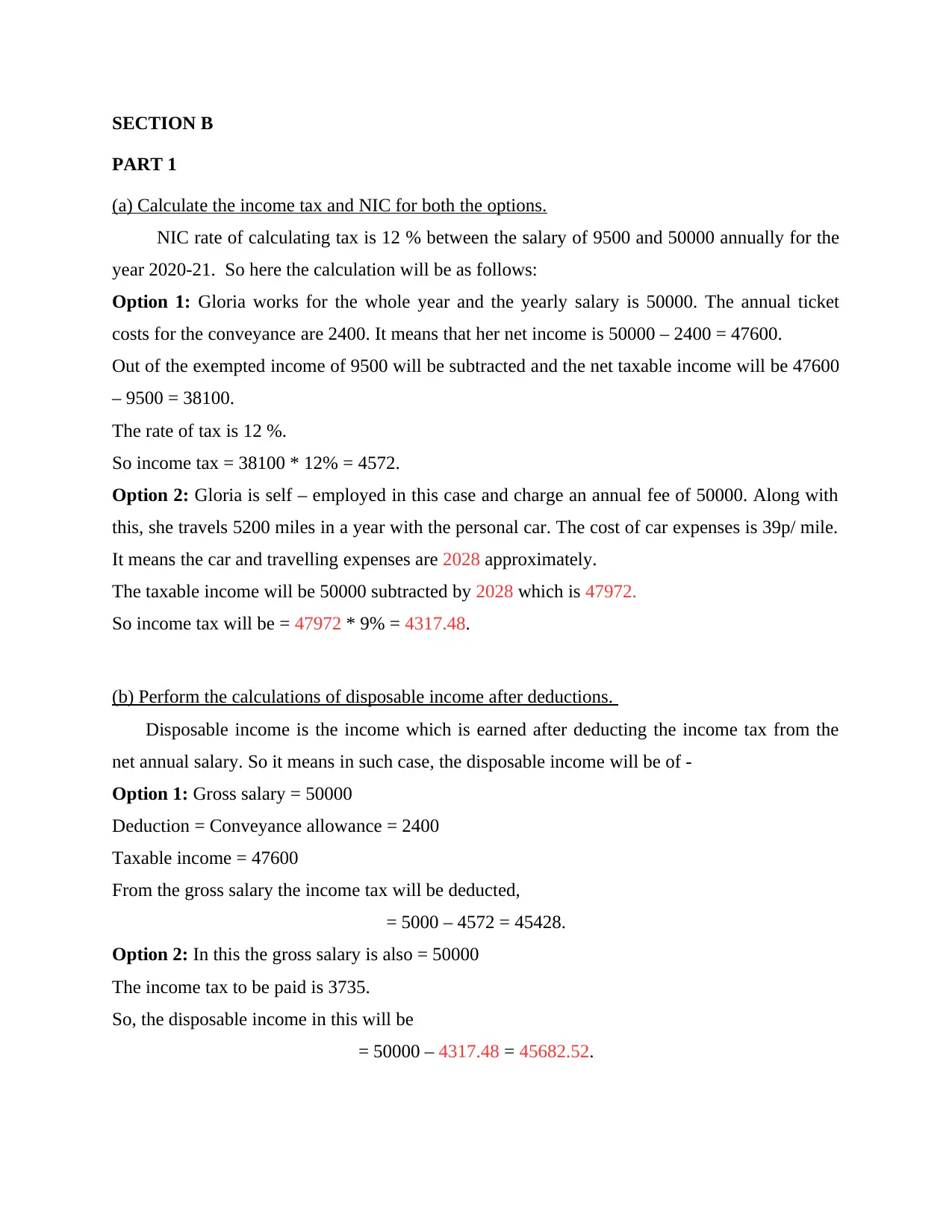
SECTION B
PART 1
(a) Calculate the income tax and NIC for both the options.
NIC rate of calculating tax is 12 % between the salary of 9500 and 50000 annually for the
year 2020-21. So here the calculation will be as follows:
Option 1: Gloria works for the whole year and the yearly salary is 50000. The annual ticket
costs for the conveyance are 2400. It means that her net income is 50000 – 2400 = 47600.
Out of the exempted income of 9500 will be subtracted and the net taxable income will be 47600
– 9500 = 38100.
The rate of tax is 12 %.
So income tax = 38100 * 12% = 4572.
Option 2: Gloria is self – employed in this case and charge an annual fee of 50000. Along with
this, she travels 5200 miles in a year with the personal car. The cost of car expenses is 39p/ mile.
It means the car and travelling expenses are 2028 approximately.
The taxable income will be 50000 subtracted by 2028 which is 47972.
So income tax will be = 47972 * 9% = 4317.48.
(b) Perform the calculations of disposable income after deductions.
Disposable income is the income which is earned after deducting the income tax from the
net annual salary. So it means in such case, the disposable income will be of -
Option 1: Gross salary = 50000
Deduction = Conveyance allowance = 2400
Taxable income = 47600
From the gross salary the income tax will be deducted,
= 5000 – 4572 = 45428.
Option 2: In this the gross salary is also = 50000
The income tax to be paid is 3735.
So, the disposable income in this will be
= 50000 – 4317.48 = 45682.52.
PART 1
(a) Calculate the income tax and NIC for both the options.
NIC rate of calculating tax is 12 % between the salary of 9500 and 50000 annually for the
year 2020-21. So here the calculation will be as follows:
Option 1: Gloria works for the whole year and the yearly salary is 50000. The annual ticket
costs for the conveyance are 2400. It means that her net income is 50000 – 2400 = 47600.
Out of the exempted income of 9500 will be subtracted and the net taxable income will be 47600
– 9500 = 38100.
The rate of tax is 12 %.
So income tax = 38100 * 12% = 4572.
Option 2: Gloria is self – employed in this case and charge an annual fee of 50000. Along with
this, she travels 5200 miles in a year with the personal car. The cost of car expenses is 39p/ mile.
It means the car and travelling expenses are 2028 approximately.
The taxable income will be 50000 subtracted by 2028 which is 47972.
So income tax will be = 47972 * 9% = 4317.48.
(b) Perform the calculations of disposable income after deductions.
Disposable income is the income which is earned after deducting the income tax from the
net annual salary. So it means in such case, the disposable income will be of -
Option 1: Gross salary = 50000
Deduction = Conveyance allowance = 2400
Taxable income = 47600
From the gross salary the income tax will be deducted,
= 5000 – 4572 = 45428.
Option 2: In this the gross salary is also = 50000
The income tax to be paid is 3735.
So, the disposable income in this will be
= 50000 – 4317.48 = 45682.52.
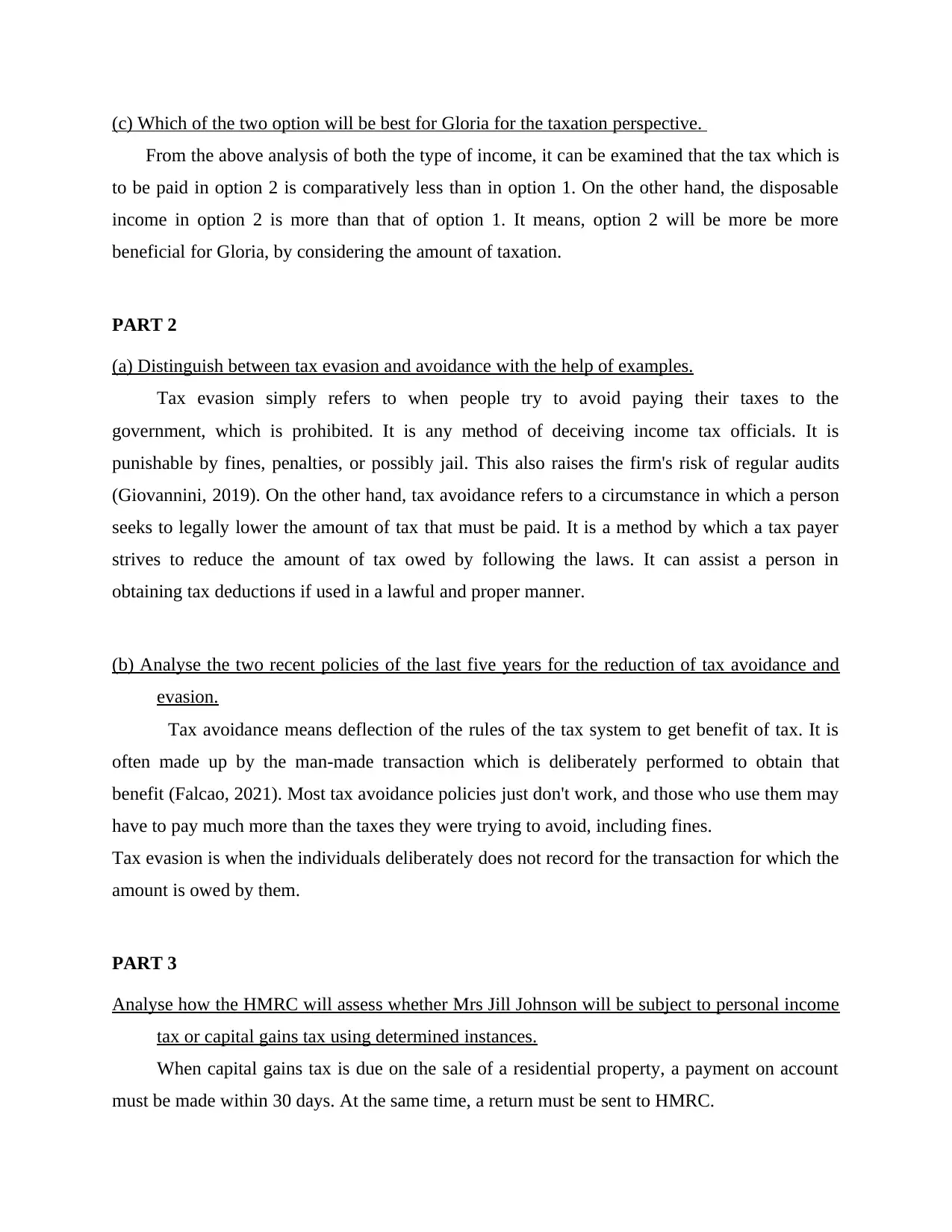
(c) Which of the two option will be best for Gloria for the taxation perspective.
From the above analysis of both the type of income, it can be examined that the tax which is
to be paid in option 2 is comparatively less than in option 1. On the other hand, the disposable
income in option 2 is more than that of option 1. It means, option 2 will be more be more
beneficial for Gloria, by considering the amount of taxation.
PART 2
(a) Distinguish between tax evasion and avoidance with the help of examples.
Tax evasion simply refers to when people try to avoid paying their taxes to the
government, which is prohibited. It is any method of deceiving income tax officials. It is
punishable by fines, penalties, or possibly jail. This also raises the firm's risk of regular audits
(Giovannini, 2019). On the other hand, tax avoidance refers to a circumstance in which a person
seeks to legally lower the amount of tax that must be paid. It is a method by which a tax payer
strives to reduce the amount of tax owed by following the laws. It can assist a person in
obtaining tax deductions if used in a lawful and proper manner.
(b) Analyse the two recent policies of the last five years for the reduction of tax avoidance and
evasion.
Tax avoidance means deflection of the rules of the tax system to get benefit of tax. It is
often made up by the man-made transaction which is deliberately performed to obtain that
benefit (Falcao, 2021). Most tax avoidance policies just don't work, and those who use them may
have to pay much more than the taxes they were trying to avoid, including fines.
Tax evasion is when the individuals deliberately does not record for the transaction for which the
amount is owed by them.
PART 3
Analyse how the HMRC will assess whether Mrs Jill Johnson will be subject to personal income
tax or capital gains tax using determined instances.
When capital gains tax is due on the sale of a residential property, a payment on account
must be made within 30 days. At the same time, a return must be sent to HMRC.
From the above analysis of both the type of income, it can be examined that the tax which is
to be paid in option 2 is comparatively less than in option 1. On the other hand, the disposable
income in option 2 is more than that of option 1. It means, option 2 will be more be more
beneficial for Gloria, by considering the amount of taxation.
PART 2
(a) Distinguish between tax evasion and avoidance with the help of examples.
Tax evasion simply refers to when people try to avoid paying their taxes to the
government, which is prohibited. It is any method of deceiving income tax officials. It is
punishable by fines, penalties, or possibly jail. This also raises the firm's risk of regular audits
(Giovannini, 2019). On the other hand, tax avoidance refers to a circumstance in which a person
seeks to legally lower the amount of tax that must be paid. It is a method by which a tax payer
strives to reduce the amount of tax owed by following the laws. It can assist a person in
obtaining tax deductions if used in a lawful and proper manner.
(b) Analyse the two recent policies of the last five years for the reduction of tax avoidance and
evasion.
Tax avoidance means deflection of the rules of the tax system to get benefit of tax. It is
often made up by the man-made transaction which is deliberately performed to obtain that
benefit (Falcao, 2021). Most tax avoidance policies just don't work, and those who use them may
have to pay much more than the taxes they were trying to avoid, including fines.
Tax evasion is when the individuals deliberately does not record for the transaction for which the
amount is owed by them.
PART 3
Analyse how the HMRC will assess whether Mrs Jill Johnson will be subject to personal income
tax or capital gains tax using determined instances.
When capital gains tax is due on the sale of a residential property, a payment on account
must be made within 30 days. At the same time, a return must be sent to HMRC.
Secure Best Marks with AI Grader
Need help grading? Try our AI Grader for instant feedback on your assignments.

The annual exempt amount, any capital losses experienced in the same tax year previous to
the disposal of the residential property, and any brought forward capital losses are all factored
into the computation of the payment on account (Beckers, 2018). Any additional taxable gains or
capital losses incurred after the residential property is sold are ignored. Following the end of the
tax year, the residential property gain is still included in the taxpayer's self-assessment capital
gains tax computation, with the payment on account deducted from the total capital gains tax
due. Any additional tax due is due on the 31st of January following the end of the tax year.
A payment on account of capital gains tax is distinct from the regular self-assessment
payments on account payable on 31 January of the tax year and 31 July of the following year. It
does not examine the calculation of payments on account when more than one residential
property is sold within a tax year. So, Mrs Jill Johnson have to pay capital gain tax.
the disposal of the residential property, and any brought forward capital losses are all factored
into the computation of the payment on account (Beckers, 2018). Any additional taxable gains or
capital losses incurred after the residential property is sold are ignored. Following the end of the
tax year, the residential property gain is still included in the taxpayer's self-assessment capital
gains tax computation, with the payment on account deducted from the total capital gains tax
due. Any additional tax due is due on the 31st of January following the end of the tax year.
A payment on account of capital gains tax is distinct from the regular self-assessment
payments on account payable on 31 January of the tax year and 31 July of the following year. It
does not examine the calculation of payments on account when more than one residential
property is sold within a tax year. So, Mrs Jill Johnson have to pay capital gain tax.
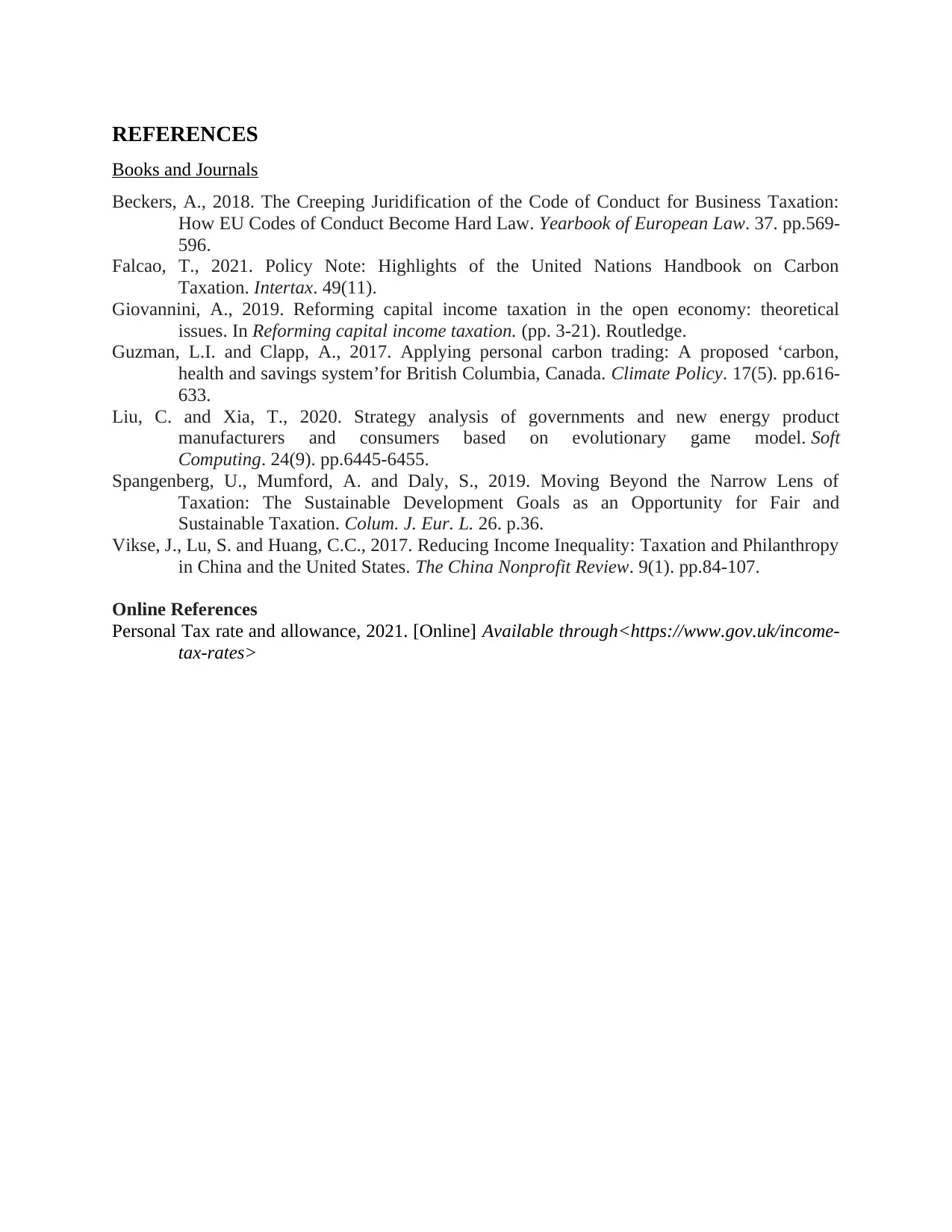
REFERENCES
Books and Journals
Beckers, A., 2018. The Creeping Juridification of the Code of Conduct for Business Taxation:
How EU Codes of Conduct Become Hard Law. Yearbook of European Law. 37. pp.569-
596.
Falcao, T., 2021. Policy Note: Highlights of the United Nations Handbook on Carbon
Taxation. Intertax. 49(11).
Giovannini, A., 2019. Reforming capital income taxation in the open economy: theoretical
issues. In Reforming capital income taxation. (pp. 3-21). Routledge.
Guzman, L.I. and Clapp, A., 2017. Applying personal carbon trading: A proposed ‘carbon,
health and savings system’for British Columbia, Canada. Climate Policy. 17(5). pp.616-
633.
Liu, C. and Xia, T., 2020. Strategy analysis of governments and new energy product
manufacturers and consumers based on evolutionary game model. Soft
Computing. 24(9). pp.6445-6455.
Spangenberg, U., Mumford, A. and Daly, S., 2019. Moving Beyond the Narrow Lens of
Taxation: The Sustainable Development Goals as an Opportunity for Fair and
Sustainable Taxation. Colum. J. Eur. L. 26. p.36.
Vikse, J., Lu, S. and Huang, C.C., 2017. Reducing Income Inequality: Taxation and Philanthropy
in China and the United States. The China Nonprofit Review. 9(1). pp.84-107.
Online References
Personal Tax rate and allowance, 2021. [Online] Available through<https://www.gov.uk/income-
tax-rates>
Books and Journals
Beckers, A., 2018. The Creeping Juridification of the Code of Conduct for Business Taxation:
How EU Codes of Conduct Become Hard Law. Yearbook of European Law. 37. pp.569-
596.
Falcao, T., 2021. Policy Note: Highlights of the United Nations Handbook on Carbon
Taxation. Intertax. 49(11).
Giovannini, A., 2019. Reforming capital income taxation in the open economy: theoretical
issues. In Reforming capital income taxation. (pp. 3-21). Routledge.
Guzman, L.I. and Clapp, A., 2017. Applying personal carbon trading: A proposed ‘carbon,
health and savings system’for British Columbia, Canada. Climate Policy. 17(5). pp.616-
633.
Liu, C. and Xia, T., 2020. Strategy analysis of governments and new energy product
manufacturers and consumers based on evolutionary game model. Soft
Computing. 24(9). pp.6445-6455.
Spangenberg, U., Mumford, A. and Daly, S., 2019. Moving Beyond the Narrow Lens of
Taxation: The Sustainable Development Goals as an Opportunity for Fair and
Sustainable Taxation. Colum. J. Eur. L. 26. p.36.
Vikse, J., Lu, S. and Huang, C.C., 2017. Reducing Income Inequality: Taxation and Philanthropy
in China and the United States. The China Nonprofit Review. 9(1). pp.84-107.
Online References
Personal Tax rate and allowance, 2021. [Online] Available through<https://www.gov.uk/income-
tax-rates>
1 out of 9
![[object Object]](/_next/static/media/star-bottom.7253800d.svg)





